Viva Art and Artists! The 2017 Venice Biennale Calls for Celebration, but is this a Time to Party?
David Ebony —
The biannual pilgrimage to Venice for the venerable, and ever more enormous international art show known as La Biennale di Venezia, is a worthwhile endeavor for anyone interested in the evolution of contemporary art. Unfailingly, the show offers a rewarding experience whether the core exhibition is a success, a failure, or something in between, as is the case with this year’s installment, the 57th. The artists and artworks highlighted in the Biennale proper—on view in Venice through November 26—and in the 86 national pavilions, and the innumerable satellite and collateral exhibitions taking place concurrently throughout the city, promise to provide a major source of art-world discourse and debate in the coming two years or more.
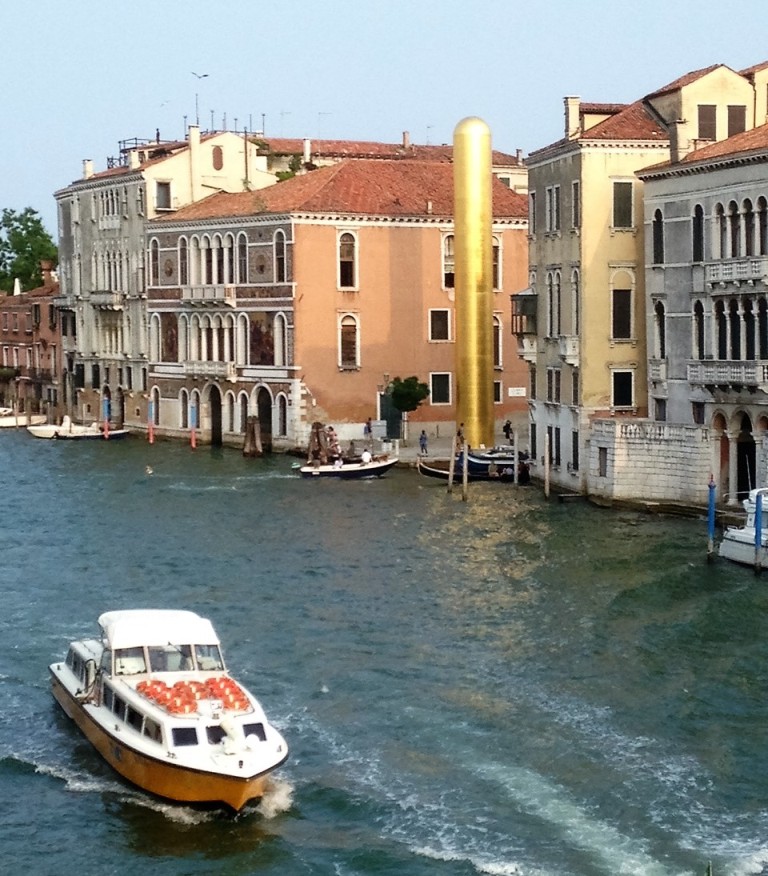
View of James Lee Byars’s The Golden Tower (1990) from the Accademia bridge, a collateral event of the 2017 Venice Biennale. Photo: D. Ebony.
At the heart of the Biennale is a sprawling group show occupying the halls of the Arsenale, a former naval yard compound, and the Central Pavilion of the Giardini, the verdant public gardens of Venice. This year’s edition, Viva Arte Viva, organized by Christine Macel, chief curator of the Musée national d’art moderne, Centre Pompidou in Paris, seeks to underscore the liberating role of the artist. “Today, faced with a world full of conflicts and shocks,” she explains in a press statement, “art bears witness to the most precious part of what makes us human, at a time when humanism is precisely jeopardized. Art is the ultimate ground for reflection, individual expression, freedom, and for fundamental questions. The role, the voice and the responsibility of the artist are more crucial than ever before within the framework of contemporary debates.”
Macel seems to call for a cultural celebration at an inopportune moment of global uncertainty. Well-meaning though the premise may be, the problem with the approach is that mounting a show on such an idealized, yet apolitical and amorphous platform has resulted in an uneven exhibition that appears conceptually flaccid, and too often visually lackadaisical. Among the works by the 120 artists, 103 of whom are making their Biennale debut, there are certainly a number of arresting pieces. And Macel’s art-for-art’s sake rubric is admirable in its celebration of the handmade work of art in contrast to the mechanically produced output of many contemporary artists. Too often, however, the show seems to emphasize craft over concept, especially in the many textile works featured. There are, frankly, too many balls of yarn on view.
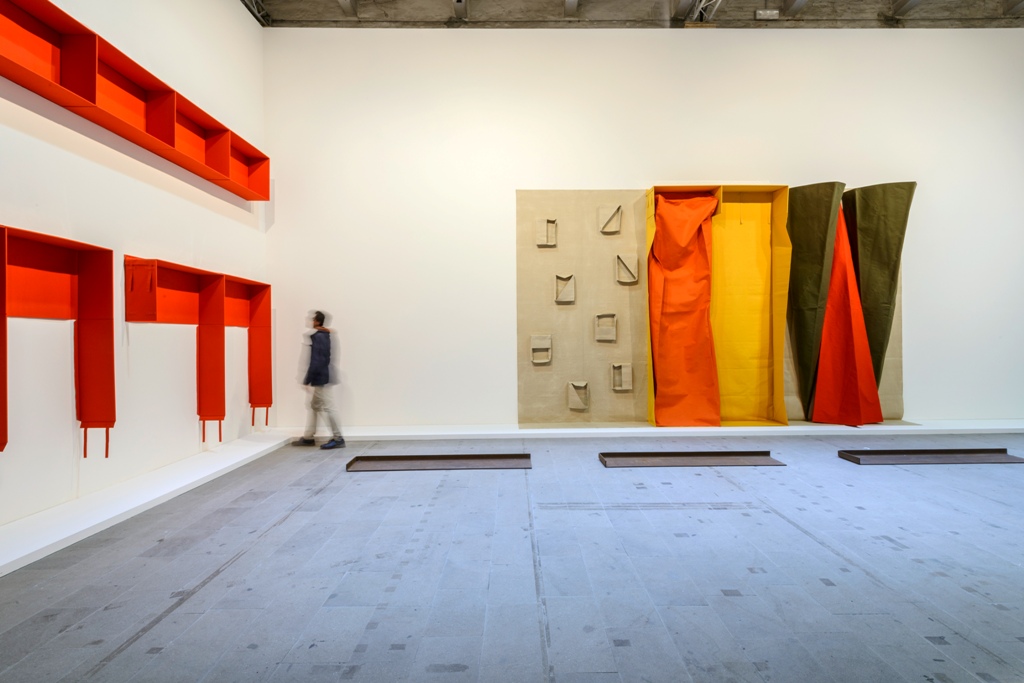
Franz Erhard Walther, Various works, 1975-1986, in Viva Arte Viva. Photo: Andrea Avezzù; unless otherwise noted all images courtesy La Biennale di Venezia.
Some of these pieces, such as the colorful, mural-scale abstract fabric wall reliefs from the 1980s, by German artist Franz Erhard Walther, are truly inspired. That the Biennale jury chose to bestow on Walther the Golden Lion for Best Artist in the Exhibition for these works is indisputable, as is the jury’s decision to present the Lifetime Achievement award to video and performance artist Carolee Schneemann.

Sheila Hicks, Escalade Beyond Chromatic Lands, 2016-2017, in Viva Arte Viva, photo: Andrea Avezzù.
Venice stalwarts such as Gabriel Orozco and Kiki Smith are on hand to demonstrate in their works the way craft and craftsmanship may enhance individual expression, as well as lend further conceptual depth to a work of art. But too many moments reveal weaknesses in the show’s premise. Near the end of the cavernous Arsenale hall, for example, Macel juxtaposes Sheila Hicks’ huge woven constructions and installation of brightly hued, oversize yarn balls, with Judith Scott’s sculptural objects bound with colorful string. While the achievement of each artist is formidable, the correspondence here—between works by a pioneer of textile art, and the heart-wrenching, obsessive efforts of an outsider who suffered from Down’s syndrome—seems absurd. In this serious curatorial misstep, the unifying element becomes merely the yarn.
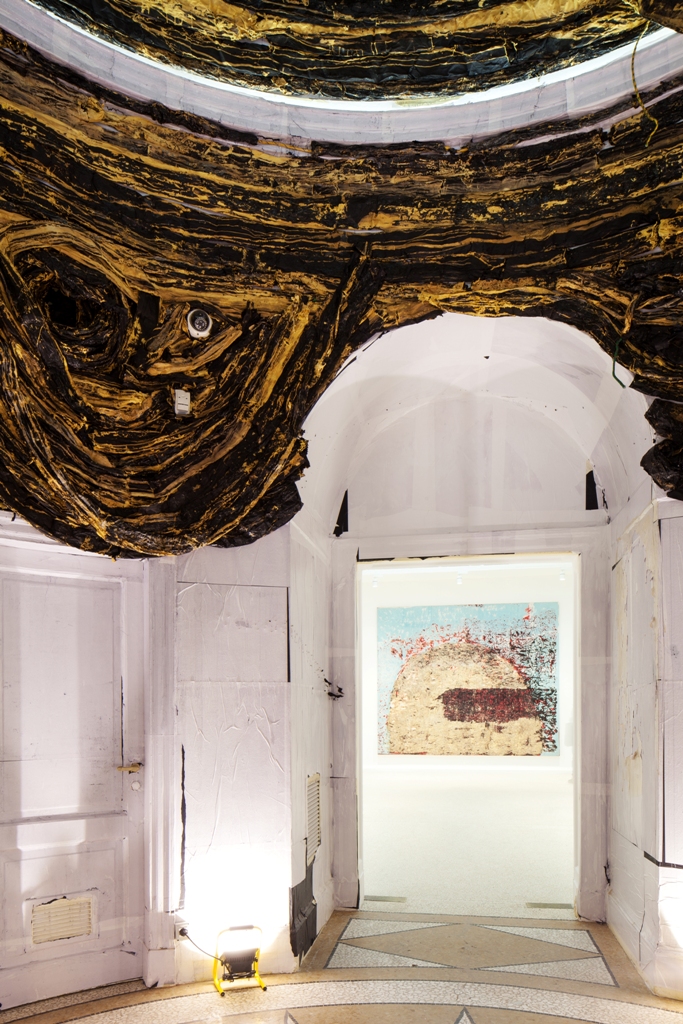
Mark Bradford, Tomorrow is Another Day, United States of America pavilion. Photo: Francesco Galli
The strength of this year’s Biennale may be found in the national pavilions, and in the many remarkable satellite exhibitions under the auspices of the Biennale, plus the collateral events or independent shows scattered throughout Venice. A recurring theme apparent in some of these presentations might be described as “futuristic archeology,” which conveys more accurately than Viva Arte Viva the anxiety of the present moment. In these shows, generally speaking, humanity faces a rather apocalyptic near future, but, after some time and reflection, may be able to redeem itself by means of the transcendent power of art. Foremost among these exhibitions, Mark Bradford’s elegant and elegiac show, Tomorrow is Another Day, in the Unites States pavilion, is one of the Biennale’s highlights.
Titled after the closing line of the Civil War epic Gone with the Wind, Bradford’s show is a strong follow up to Joan Jonas evocative exhibition here two years ago. Bradford transformed the entire building into a kind of faux ruin, as if the structure barely survived a war, or some other catastrophic event. Sagging constructions by the artist, and abject, free-standing sculptures filling certain areas of the space appear to be made of the long, oil- and tar-stained yellow tubes used for cleaning oil spills, suggesting the aftermath of some environmental disaster. The gritty textures of the walls and 3-D works are echoed in the richly textured surfaces of the artist’s luminous abstract collage-paintings hanging in other rooms of the pavilion.
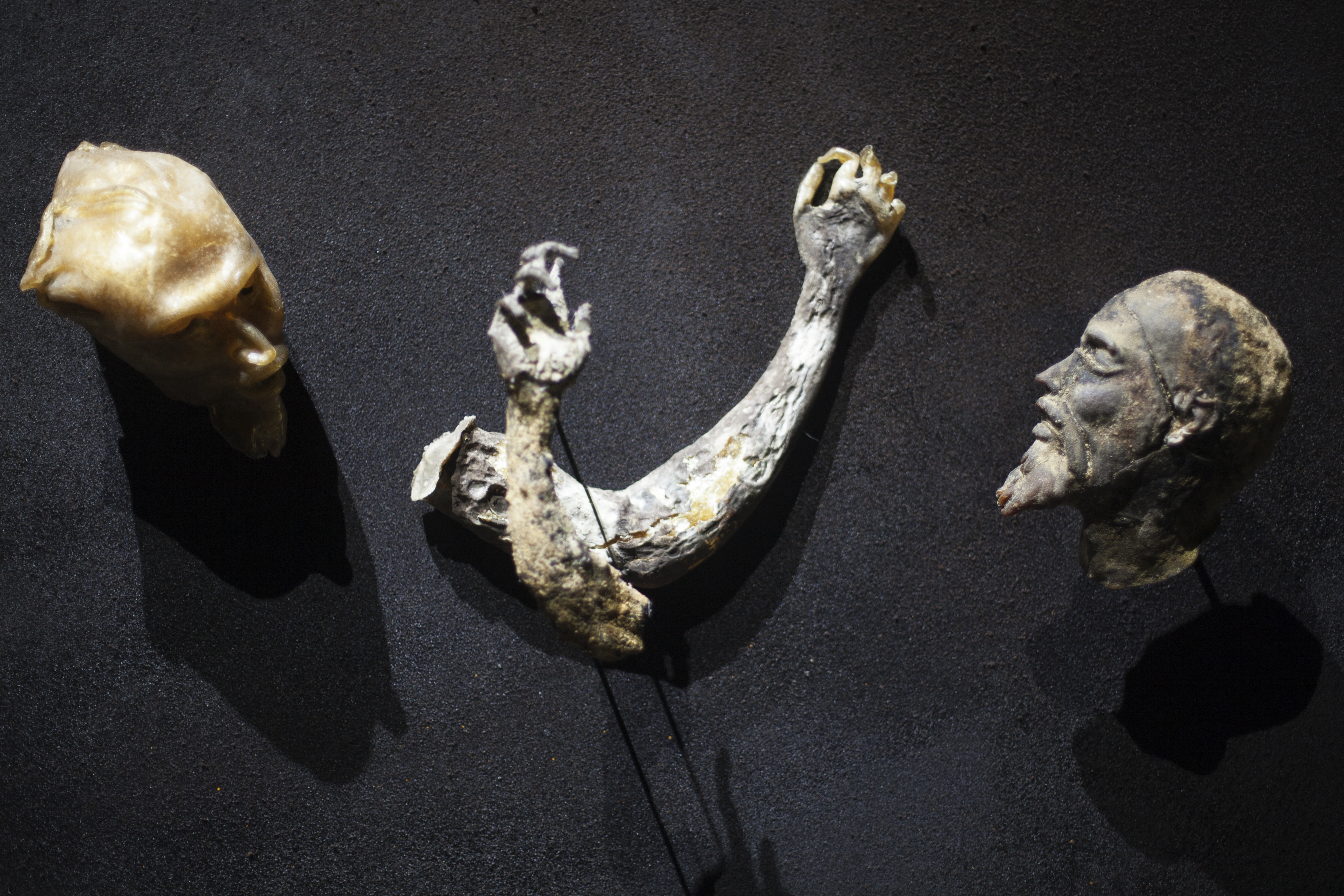
Roberto Coughi, Imitation of Christ (2017), detail; part of The Magic World, Italian Pavilion. Photo: Italo Rondinella.
Il mondo magico (The Magic World), in the expansive Italian Pavilion at the end of the Arsenale, is an outlandish presentation by Roberto Coughi, Giorgio Andreotta Calò, and Adelita Husni-Bey that addresses notions of the sacred and profane. Coughi’s offering, Imitation of Christ, a kind of Frankenstein-like laboratory operating through the duration of the show, produces each day newly minted relics of the bones of Christ. The results, hung as wall reliefs at the rear of the gallery, are uncanny and disturbing to say the least.

Phyllida Barlow, folly, Great Britain pavilion. Photo: Francesco Galli.
Elsewhere in the Giardini, sculptor Phyllida Barlow filled the Great Britain pavilion with brightly colored, oversize constructions in a playful installation appropriately titled folly. France and Germany offer overtly theatrical fare. Xavier Veilhan converted the French pavilion into a state-of-the-art recording studio, which was unfortunately bogged down in technical malfunctions when I visited. And there were long lines at the German pavilion to see a series of brief, scattershot performances taking place below visitors’ feet—that is, beneath the reinforced glass flooring. This enigmatic installation won for the artist Anne Imhof the Golden Lion award for best national pavilion.

Tracey Moffat, My Horizon, view from Australia pavilion exterior. Photo: Francesco Galli.
Representing Australia, Tracey Moffat addresses identity politics, the refugee crisis in Europe, and racial tensions, among other themes, in My Horizon, a show of two new photo series, and two recent video works. In one of the new videos, Vigil, projected on screens inside and outside of the pavilion, Moffat juxtaposes documentary footage of desperate boat refugees with film clips of glamorous Hollywood movie stars like Elizabeth Taylor, Joan Crawford, and Audrey Hepburn. The actors have expressions of shock and horror on their faces, as they ostensibly gaze upon the refugee scene. It is a jarring montage, but there’s a touch of humor in the work, as the artist manages to deliver the kind of acerbic, thought-provoking treatment of hot-button issues that seems nearly absent from Viva Arte Viva.

Iván Capote, No Rearview Mirror (2008-2016), Cuba pavilion. Photo: D. Ebony.
Among the outstanding national presentations held in various off-site locations in Venice, the Cuba pavilion features Tiempos de la Intuición (Times of Intuition), a striking group show featuring works by Iván Capote, Wilfredo Prieto, Esterio Seguro, Abel Barroso and others. Particularly unforgettable, Capote’s quasi-surrealist objects, including No Rearview Mirror (2008-2016), with letters spelling the words “Don’t Look Back” instead of numbers, seemed prescient and rather hopeful.
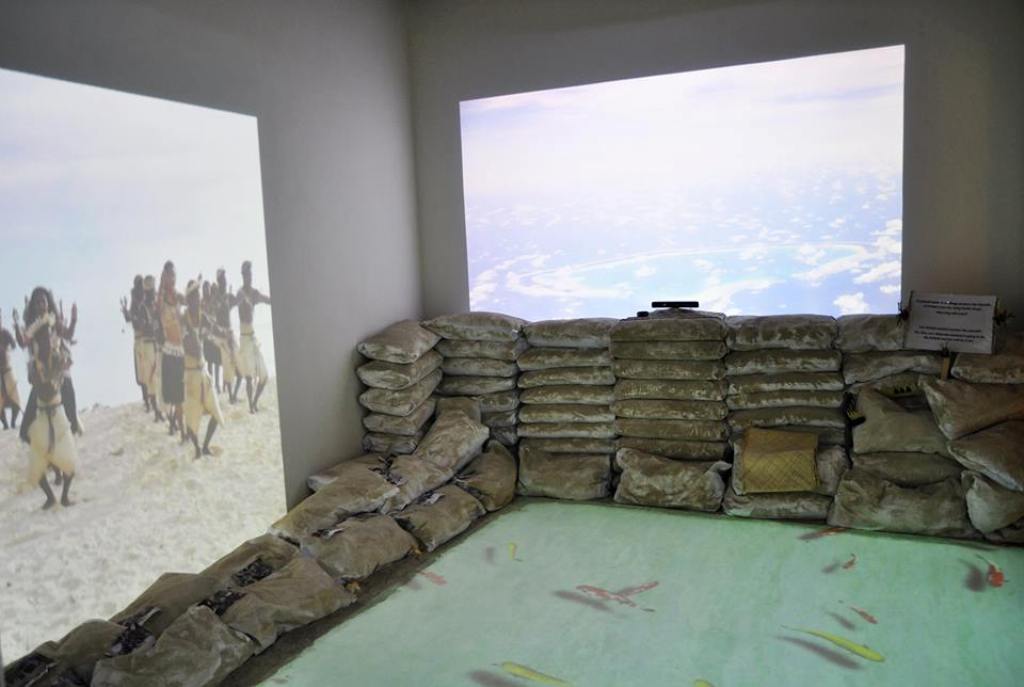
View of Ars Longa, Vita Brevis/ Sinking Islands, Unsinkable Art, 2017, at the Kiribati pavilion. Photo: Courtesy European Cultural Centre.
This year, the European Cultural Centre hosts “Personal Structures: Open Borders,” a large-scale international group exhibition held in three venues: the Palazzo Mora, Palazzo Bembo, and in one outdoor area of the Giardini. Under the auspices of the Dutch non-profit Global Art Affairs Foundation, and organized by a team of young Italian curators, the show features works by artists from 50 countries. High-profile veterans, such as Joseph Kosuth and Lawrence Weiner are represented, but the project also showcases the work of younger artists, such as Taiwan’s Li-Jen Shih, whose giant, stainless steel King Kong Rhino drew a great deal of attention near the Giardini entrance; and New York’s Richard Humann, whose high-tech contribution to the exhibition, Ascension, includes an “augmented reality app” that allows one to view imaginary constellations visible above Venice each night of the Biennale.
The Palazzo Mora is also home to the Kiribati National Pavilion, which presented one of the Biennale’s most engaging and poignant installations. The existence of the Pacific island nation of 100,000, basically confined to a sequence of coral reefs and atolls, is now threatened due to rising sea levels in the face of global warming. A collaborative effort of 35 artists, Ars Longa, Vita Brevis/Sinking Islands, Unsinkable Art, is a compact but intense environment with a floor activated by interactive video projections. Visitors’ movements trigger images of swimming tropical fish underfoot. Sandbags lining the gallery refer to the rising sea. And, projected on one wall, video footage of groups of island inhabitants singing and dancing on a beach whose days are numbered, can be emotionally wrenching.
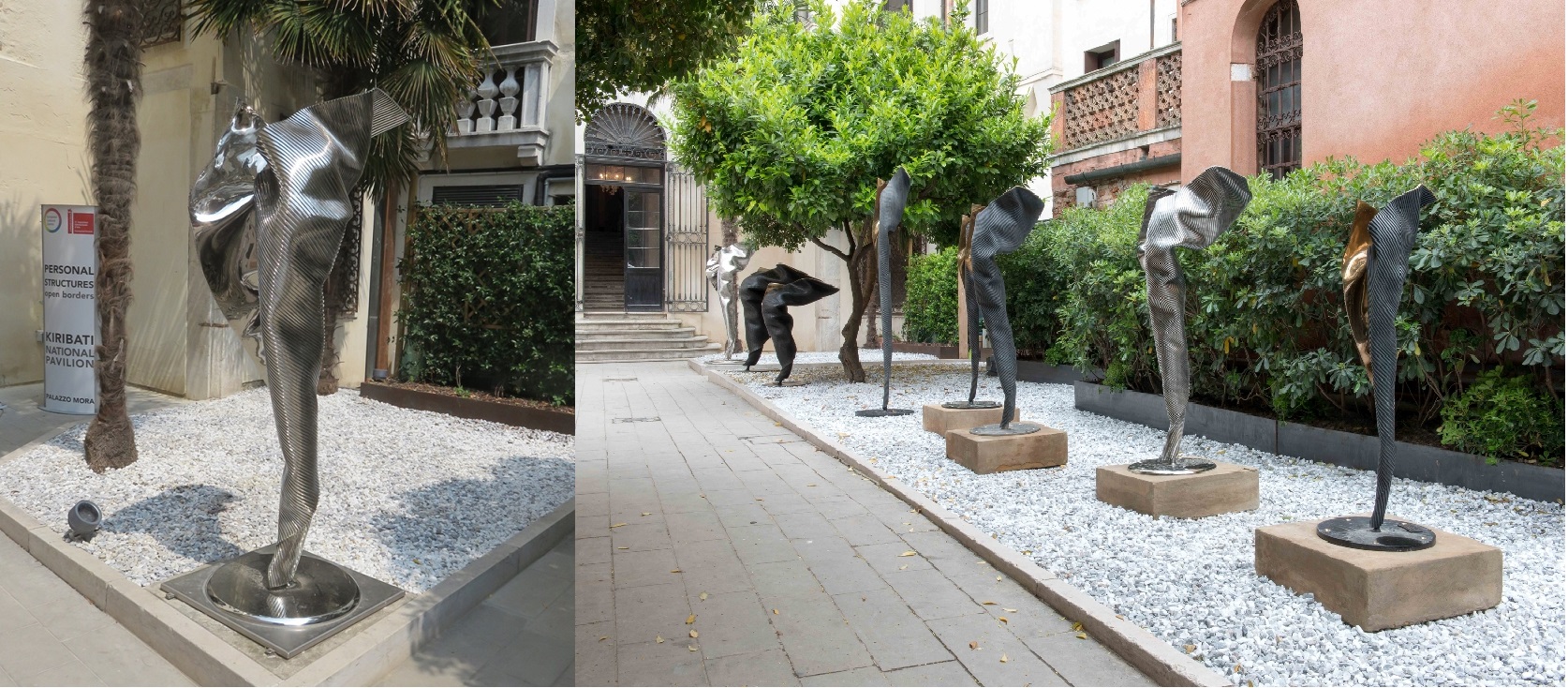
right, Andrew Rogers, We Are, 2017 installation at the Palazzo Mora; left, I Am (2015); Photos: Courtesy Global Art Affairs Foundation.
The courtyard entrance to the Palazzo Mora is lined with a series of eight elegant, quasi-abstract bronzes by Andrew Rogers. The Australian artist is best-known for his vast land-art projects, Rhythms of Life, which he has created in many, mostly remote places around the globe. For the past three decades or more, Rogers has also produced free-standing sculptures. Here, in the urban—and urbane—environment of Venice, he presents intimate, human-scale pieces in bronze, collectively titled We Are. The totemic forms appear as abstracted figures, like sentinels guarding the palazzo treasures, perhaps. The works resemble unfurling flags, or billowing sails, which, metaphorically at least, refer to the human figure. As in the comportment of an individual, each piece bears the physicality of a rough exterior contrasted with highly polished interior surfaces. These attributes allude to the outward, self-protective stance one must possess in order to survive, and the literally reflective interior world of thoughts and emotions.
On a formal level, We Are corresponds to the billowing fabric and dramatic theatricality of Baroque art and architecture that is visible everywhere in Venice. Rogers speaks for many artists participating in the Biennale and collateral shows as he comments in a press statement, “To be surrounded in Venice by Tintorettos, Titians, and Bellinis, some of the greatest art in the world, and by a cultural history that reaches back more than a thousand years, is a truly transformative experience. To have a major exhibition of sculpture in Venice at the time of the Biennale is a great honor and privilege.”

El Anatsui, The Beginning and the End (2015); and left, Masaomi Raku, Transmigration (2016), in Intuition at the Palazzo Fortuny. Photo © Jean-Pierre Gabriel.
Corresponding to Rogers’s work in the way it echoes the fluid lines in Venetian Baroque paintings, a resplendent, textile-like wall relief made of bits of found metal, The Beginning and the End (2015) by Ghanaian artist El Anatsui, graces one long wall in Intuition. This collateral show, the last in a series of special exhibitions hosted by Belgian dealer Axel Vervoordt at the Palazzo Fortuny in Venice, and co-curated by Daniela Ferretti, features historical works ranging from Neolithic stone menhirs, circa 3000 B.C., to large, recent photos of fish eyes by Italian artist Bruna Esposito. Throughout the moodily lit rooms of the palazzo are top-notch works by artists like Lucio Fontana, Jean-Michel Basquiat, Anish Kapoor, and Marina Abramovic. An interactive, meditative work on the palazzo’s top floor, created especially for this exhibition by Kimsooja, Archive of Mind, invites visitors to sit at a table and mould spheres from lumps of clay. There could not possibly be a better way of spending a quiet hour or two of a summer afternoon in Venice—rolling balls of clay while looking out the windows over the rooftops of ancient buildings along the Grand Canal.

Philip Guston, Pittore (1973), ©The Estate of Philip Guston, Private Collection; Photo: Genevieve Hanson, courtesy Hauser + Wirth.
To coincide with the Biennale, one of Venice’s premier museums, the fabled Accademia gallery, presents a rare exhibition of modern or contemporary art. Philip Guston and the Poets [on view through September 3] is a remarkable survey of some 50 paintings and 25 works on paper by the Canadian-American painter who spent a considerable amount of time in Italy, and had a special relationship with Italian art. The works on view explore the ways his painting was inspired by literature, particularly the work of five poets: W.B. Yeats, D.H. Lawrence, Wallace Stevens, T.S. Eliot, and Eugenio Montale.
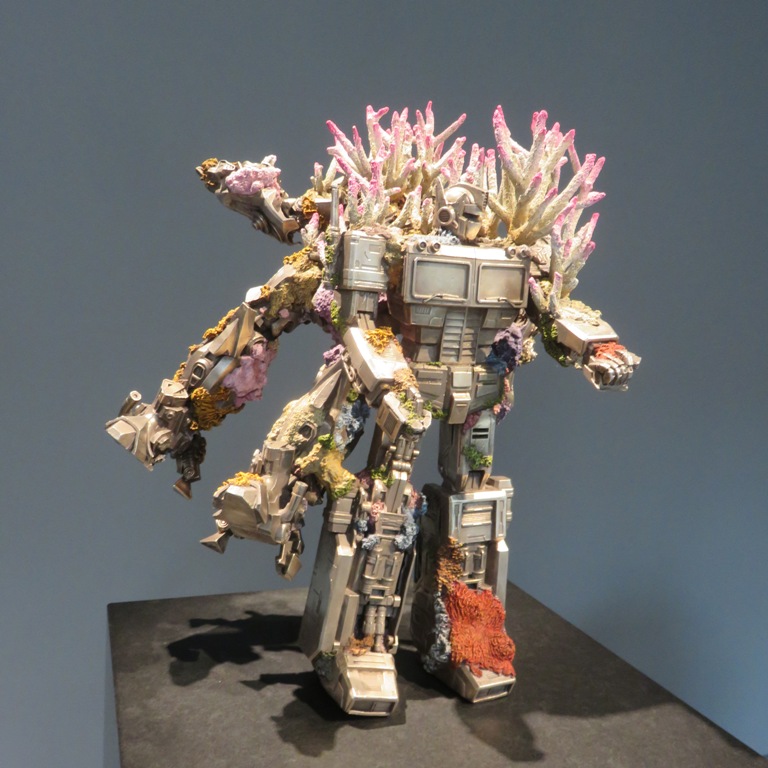
Damien Hirst, Huehueteotl and Olmec Dragon (2017), from Treasures from the Wreck of the Unbelievable, at the Palazzo Grassi. Photo: D. Ebony; Artwork © Damien Hirst, and Science Ltd.
For his two-museum Venice extravaganza, Treasures from the Wreck of the Unbelievable, Damien Hirst conjured an ancient ghost ship filled with faux-antique sculptures and artifacts. He produced a video of the 2008 “discovery” of the ship to make it seem as it were not just fake news. Under the auspices of the Pinault Collection museums, the Punta della Dogana, as well as the Palazzo Grassi display the trove hauled from the would-be underwater archaeological site. The ship was supposed to have sunk off the coast of East Africa sometime during the late Roman Empire. How mollusk-encrusted statues of Mickey Mouse and Goofy, and coral-laden robotic action figures from the 21st century wound up among the antique “treasures” is anyone’s guess. Some observers have noted similarities between Hirst’s work and the underwater installations of Jason deCaires Taylor, concurrently on view at the Grenada pavilion. For the past decade or more, however, Hirst has been honing his futuristic archeology with a broad, and often compelling mythological basis. The new work is as much an exploration of museology, the ways art history can be constructed—if not reinvented—and the conception of the art world itself, as it is a novel exploration of the formal concerns in contemporary sculpture or installation. In the end, Hirst’s “treasures” are alternately funny and thought-provoking, irksome and profound, just as Viva Arte Viva could or should have been.
___________________________________________________________
David Ebony is currently a Contributing Editor of Art in America magazine. Among his books are Arne Svenson: The Neighbors (2015); Anselm Reyle: Mystic Silver (2012); Carlo Maria Mariani in the 21st Century (2011); Emily Mason (2006); Botero: Abu Ghraib (2006); Craigie Horsfield: Relation (2005); and Graham Sutherland: A Retrospective (1998). He lives and works in New York City.























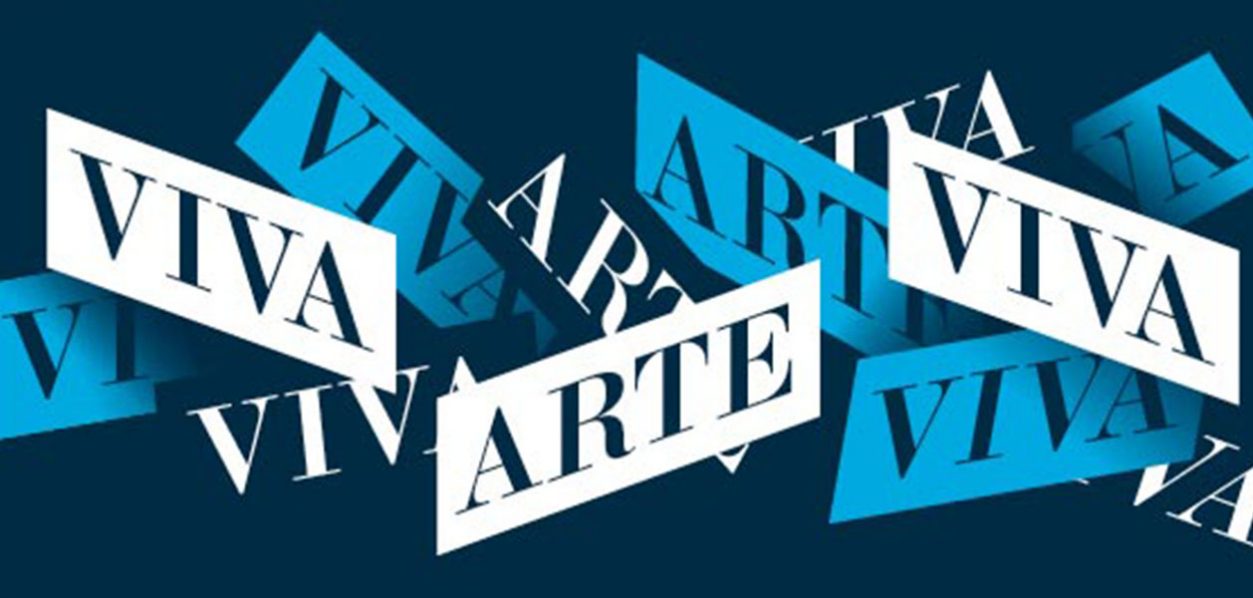
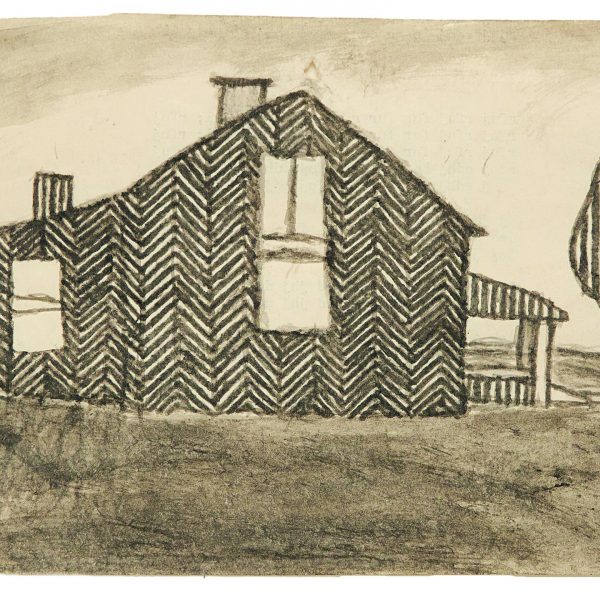
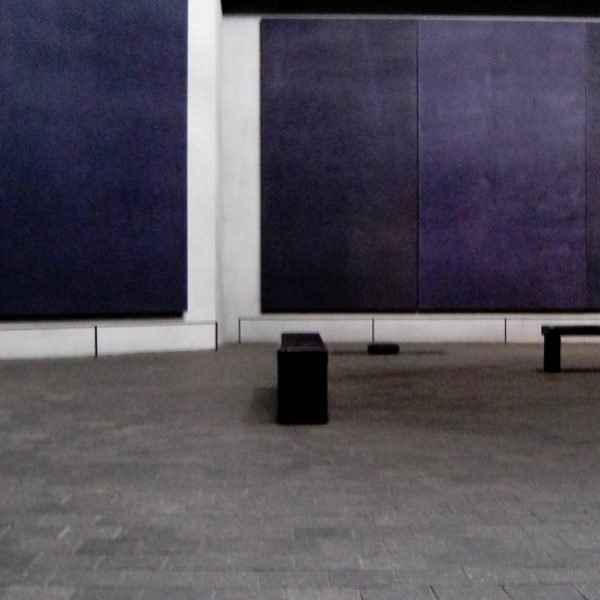
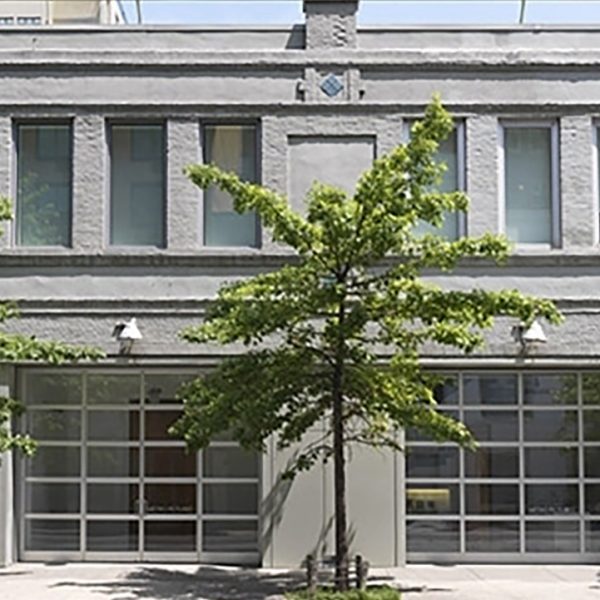
I wonder what kind of comments the Venice article is receiving??
Thanks for a well researched article on the Biennale and more importantly the satellite exhibitions that are often overlooked by art market professionals and writers. The huge Personal Structures show with more than 200 artists (of which I am one) from over 40 countries also provides a stimulating alternative to the razzmatazz of the Giardini and Arsenale exhibits. With famous artists like Jeff Koons (on the other side of the wall of my syringe wall sculptures )Francois Morellet and Julian Opie next to lesser known “emerging artists” it is a radical and exciting show that deserves to be seen. Yes, there is a poignant irony to the Kiribati Islands, with their fragile ecosystem falling victim to rising sea levels in the next 30 – 60 years exhibitiing in a city that is also constant threat of flooding. Bravo for the article !